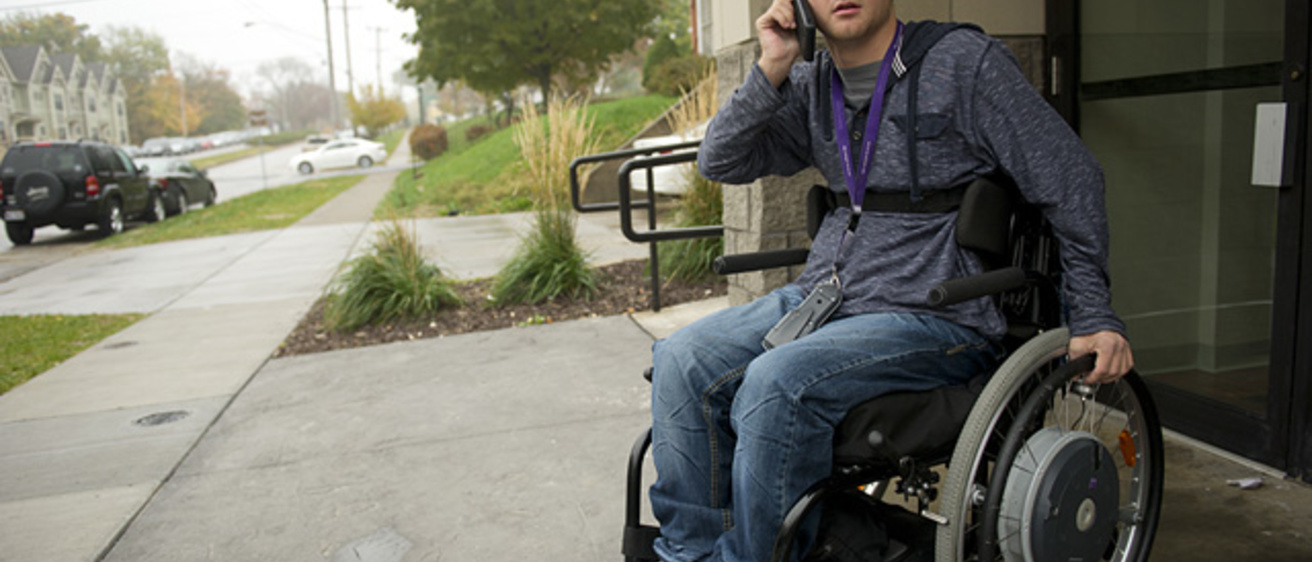A few years back, Travis Taylor made history in the small, west-central town of Callender, Iowa: he was the town’s first state wrestling champion.
He would wrestle competitively across the nation. And he ended up coming to the University of Iowa, home to the storied program once led by the legendary Dan Gable.
But wrestling wasn’t the draw.
Taylor, now 23, broke his neck in a tragic swimming accident in 2010. The No. 2 nationally ranked Rehabilitation Counseling Programs in the UI College of Education were the draw, when Taylor recognized he could transform his tragedy into an opportunity to help others with spinal cord injuries. That he could do more than just survive—he could succeed.
His physical medicine and rehabilitation specialist, Heather Bingham, a clinical assistant professor in the Department of Orthopaedics and Rehabilitation with UI Hospitals and Clinics, encouraged him to explore the Rehabilitation Counselor Education Program.
His younger brother, Brayton, is also a student at the UI, which was another draw for Taylor. The two are now, in fact, roommates.
Having an internationally recognized wrestling team at the university made the choice even easier.
“As a lifelong Hawkeye fan, that was just the icing on the cake,” Taylor says ruefully, adding he hopes to attend many of the meets at Carver-Hawkeye this coming season.
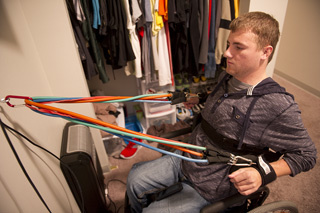
Life changed in a split second
July 3, 2010, was a sweltering summer day in Iowa—the kind of day perfect for a backyard barbecue and a cool dip in the pool.
Taylor and his friends were riding bicycles in the Firecracker 40 as part of the Gowrie Fourth of July celebration. When they got to Farnhamville, they took a few minutes to cool off in a friend's pool.
A naturally athletic person and a strong swimmer, Taylor remembers diving in and trying to avoid landing on a group of his friends. He misjudged the distance and hit his head on the bottom of the pool. He doesn't even remember feeling pain. Everything went instantly black.
Panicked, his friends called 911, and an ambulance rushed the unconscious Taylor to Iowa Methodist Medical Center in Des Moines.
When he gained consciousness two days later, he was lying in a hospital bed, hooked up to a ventilator, and feeling excruciating pain around his neck and head.
But nowhere else.
He doesn't even recall being worried about not feeling any additional sensation at the time, and he can't recall who actually delivered the news: you shattered your C5 vertebrae.
In layman's terms, his neck was broken—the fifth bone in his spinal column, which can result in quadriplegia or other neurological problems if the spinal cord is damaged due to swelling and laceration.
In Taylor's case, he had some of both. But Taylor recalls that no one said, “You’re a quadriplegic,” because everyone’s recovery is so individual.
"They can never really tell you fully what level of mobility you’ll achieve because everyone can recover differently and someone with the same injury could function way differently,” Taylor says, who underwent several surgeries including an anterior cervical corpectomy. “Someone with a C5 injury could, for example, have no wrist function.”
The same tenacity and resilience that propelled him to excel on the mat now drove his desire to push the parameters of his rehabilitation.
"Honestly that’s what helped me get through my injury a lot,” Taylor says. “Growing up, I wrestled a lot so it gave me that mental edge of you’ve got to keep going. So during my recovery, I just wouldn’t let myself slack off. “
Taylor's innate tenacity and resilience—and his family's love and support—got him through.
“I couldn’t be more thankful really, especially for my family being there for me and never looking back,” Taylor says. “They just kept me positive. They didn’t allow any time to focus on any negative.”
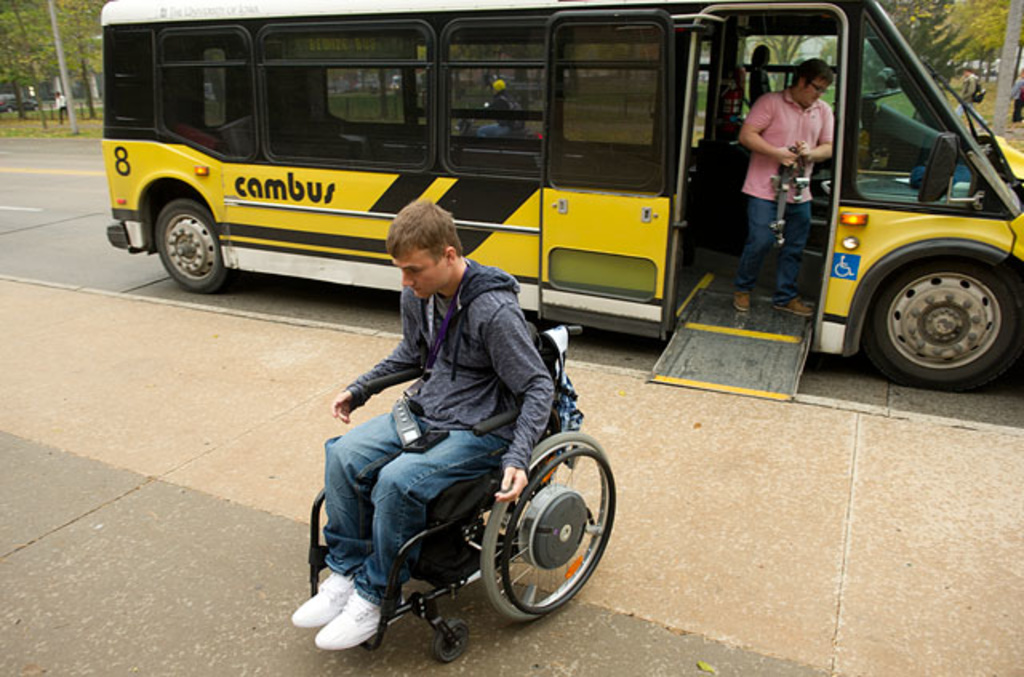
Taylor says, for him, the physical challenges were greater than the emotional ones.
“I think the most painful part was the actual transition of getting back up into a wheelchair because your body had to get used to using all the different muscles again,” Taylor says, adding he was at Mercy in Des Moines for three weeks where he underwent several surgeries and was then transferred to Craig Hospital in Colorado for additional physical rehabilitation.
The focus there was totally on recovery, Taylor says. “The faster you got up and started being productive and moving around, the better.”
Initially, his blood pressure would fluctuate wildly doing things like moving from lying down to getting into a sitting position.
When he first went to Craig Hospital, he was able to move his shoulders a little bit. While there, Taylor says he was able to regain movement in his arms and wrists using therapeutic bands, which he continues to use to maintain as much muscle strength as possible.
"I don’t have any finger movement but I can move my wrists,” Taylor says, adding he can grip items such as his cell phone or his car controls. He also has some sensation in his hands and right leg.
He now drives a modified Honda Element that allows him to accelerate and brake from a side lever that he controls with his left hand while steering with the right hand. With a touch of a button on a key fob, the car doors pop open and a ramp folds out allowing him to push himself up into and lock down, and then away he goes.
While some people might wonder if it was even more difficult to adjust to a life as a quadriplegic due to how much his identity was tied to being a wrestler and his physical prowess, Taylor says it was the opposite.
“I think it helped me more because I was so physically active, I could do a lot more thanks to being really in shape and flexible from conditioning as a wrestler,” Taylor says. “I had better balance and more strength and knew how to compensate for certain muscles that wouldn’t work.”
For example, Taylor’s triceps don’t work in his arms. “So compensating with the little muscles like that helped a lot.”
Taylor says he even surprised his specialists in Colorado.
“Just being a wrestler and being used to different positions helped a lot,” Taylor says. “I think that made my rehabilitation process faster.”
Bingham, who started seeing Taylor about one year after his injury, says she and her colleagues see about 200 patients a year with spinal cord injuries or diseases.
While she works with some patients to help manage the long-term complications of spinal cord injuries such as spasticity management or equipment prescriptions, she also provides emotional support.
“Although living with a spinal cord injury hasn't always been easy, Travis has been able to maintain a positive outlook and was able to graduate from college,” Bingham says, who began seeing him while he was still working on his undergraduate degree. “I knew that working as a counselor would give Travis the opportunity to bring his own experiences and optimism to his work, and hopefully someday he'll be able to work with people with new injuries and teach them that it is possible to have a successful, happy, healthy life even with a disability.”
One of the hardest parts for Taylor to initially adjust to was the loss of independence.
“When you’re in your wheelchair and you want to go do something yourself or transfer from your chair to the bed, I was just really frustrated but it also made me want to work harder,” Taylor says.
Another challenge was the reaction from friends, some who were uncomfortable around him and didn’t know how to approach him. Others stuck by him.
But he doesn’t take it personally.
“I feel like that’s just every day society, really,” Taylor says. “Some people can approach people with disabilities, and some people are more hesitant or they don’t know what to do.”
Appreciate the little stuff
In some odd ways, Taylor’s injury actually improved his life.
Before his injury, Taylor first attended Morningside College in Sioux City on a wrestling scholarship for one year. He then transferred to Iowa Central Community College where he obtained his associate degree in criminal justice.
Taylor’s injury occurred the summer after he finished his associate degree, and he ended up taking several months off while he underwent extensive rehabilitation.
After his injury, Taylor continued to work toward a human services and criminal justice degree at Buena Vista College through taking night classes at the Iowa Central Community College campus twice a week.
“Before the injury, I didn’t take school that tremendously seriously,” Taylor says. Now he takes nothing for granted and is driven to excel in his graduate studies.
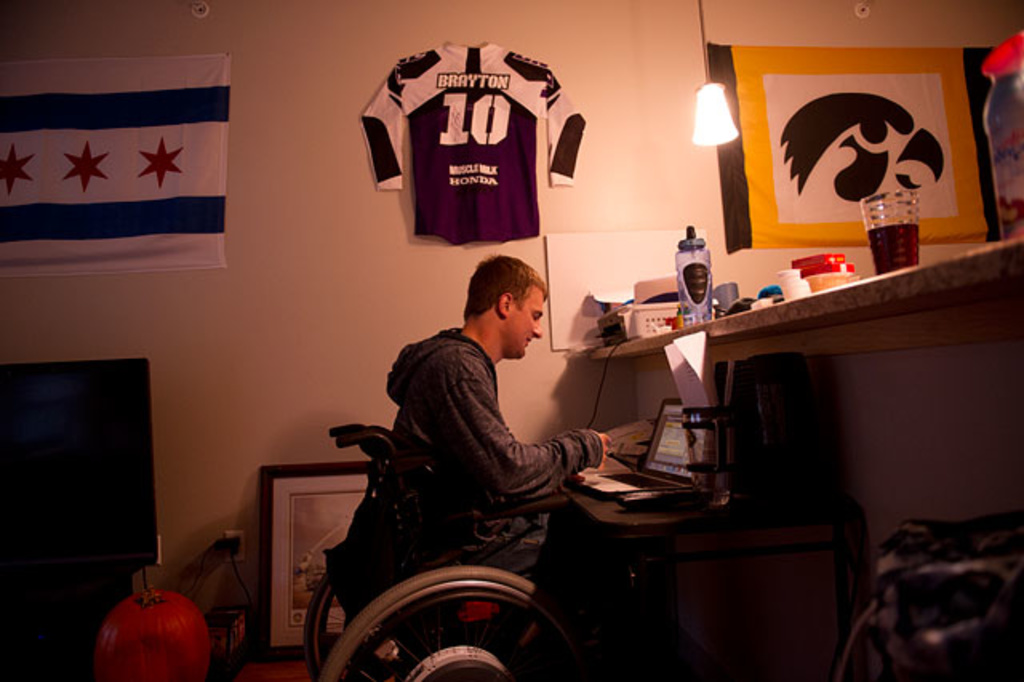
Taylor says he also has a much more profound appreciation for what really matters most in life.
“Look at the little stuff and just appreciate everything,” Taylor says. “Just the little opportunities—and if you're having a bad day, just think, 'It could be so much worse."
Things did get worse in 2012. Just as he was preparing to graduate from Buena Vista University, Taylor’s father, who was only 45, died in a tragic accident on May 31.
“I just really needed to focus and figure out what I was going to do next,” Taylor says, adding the combination of his own injury and the loss of his father compelled him to do more with his life.
Instead of becoming depressed, Taylor channeled his grief into his new graduate studies.
His advisor, John Wadsworth, associate professor of rehabilitation and counselor education, says that Taylor's story demonstrates that when people feel empowered, that investment multiplies itself in a greater good for many.
“Travis is already touching the lives of Iowans in similar difficult circumstances through outreach and service learning,” Wadsworth says. “He has lived through the highs and lows of rehabilitation, and his willingness to share that experience makes us better practitioners and educators.”
Taylor says that the UI does a great job of providing adaptive technology and tools to make it easier for him to fully participate in classes. He notes the presence of the College of Education’s I-CATER (the Iowa Center for Assistive Technology Education and Research) as critical for people in his field and life situation.
He also uses Dragon NaturallySpeaking, a speech-recognition software program that allows him to speak into a microphone that will transcribe his ideas into text for research papers and class assignments.
The faculty and staff in the UI Rehabilitation Counselor Education program are also top-notch, Taylor says, adding he appreciates the small class sizes.
“There’s a lot of one-on-one time, and the professors are actively involved and that’s really important to me,” Taylor says. “With a big program, you’re not getting the time of day, and here they’re working with you one-on-one and really get to know you personally.”
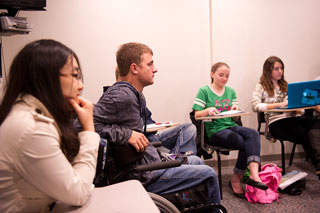
His program involves three semesters of classroom work and one semester of internship, which includes a practicum and advanced practicum.
“What I’ve really learned from my classes so far is that as a counselor you need to focus on your clients,” Taylor says. “You’re not providing them with the answers. You’re going to help them succeed and find their own way.”
“For a lot of people with disabilities, it’s such a life-changing transition, and there might not be the family support there,” Taylor says. “So they resort to substance abuse.”
Taylor says he tries to balance his studies with staying physically active, traveling the four blocks in his power wheelchair from his East Washington street apartment to the Lindquist Center whenever the weather allows. Other days, he takes the Bionic Bus.
Taylor has home health nurses who help him with grooming and small tasks before he leaves for the day. He says his biggest challenge when he moved to Iowa City this past summer was finding an apartment with the modifications for a quadriplegic, which involves having a roll-in shower and elevators.
He loves to get outside whenever he can and tries to use his Thera-bands, which are hand-therapy tools, several times a week.
Recognized as positive role model
Even though Taylor has only been on campus since June, he has already experienced several significant events. Oct. 17, UI President Sally Mason presented him with the 2013 David and Rosalie Braverman Scholarship for being a positive role model for others with disabilities. The award was given on behalf of the UI Foundation and Student Disability Services. See a related story here.
Then, Oct. 26, Taylor’s mom, Tammy, was honored as one of the Parents of the Year during UI Family Weekend before the Iowa-Northwestern game at Kinnick Stadium. She was nominated by her two Hawkeye sons for her amazing support and courage during so many significant life changes in a short span of time. See related story here.
Taylor especially credits his mom for helping him stay positive.
“Anytime I would get down, I could just give her a call, and she’d say something and just make my day feel a lot better,” Taylor says.
Tammy says she is so proud of all of her sons, but especially Travis, whom she credits as being a positive role model for others.
“He always says that I'm his inspiration, but I tell him he's my inspiration,” Tammy says. “Travis shows others that people with disabilities can do anything, but that it's also OK to ask for help. So many people have helped him at Iowa, and we are so thankful to all of them.”
Tammy says Travis’ UI degree will allow him to use both his empathy and education to help others in similar situations.
After obtaining a master’s degree, Taylor says he hopes to work in a spinal cord clinic as a vocational rehabilitation counselor, possibly in a VA clinic, helping others in his situation live full and productive lives.
One of his mantras is to stay positive and always look to the future, not allowing himself to wallow in regrets or dwell on what life might have been like had he not jumped into the pool that day.
“I've just got to focus on what's here and now, appreciate the little things, and always just keep moving forward,” Taylor says.
